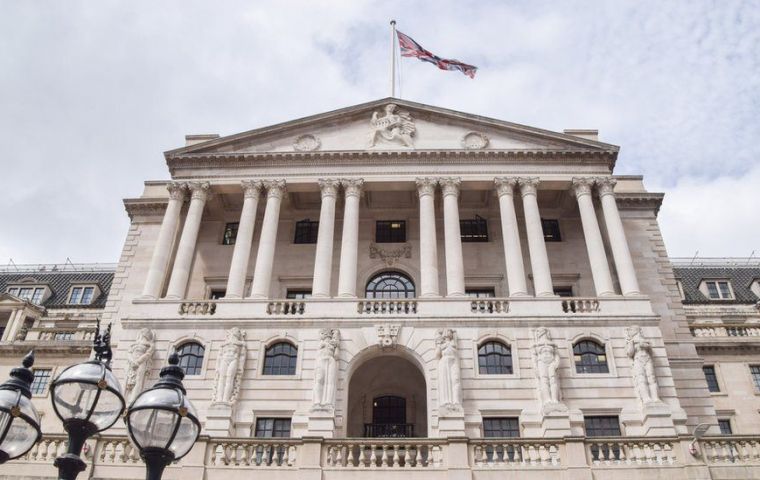MercoPress. South Atlantic News Agency
Bank of England leaves basic rate at 5,25%; little space for any cuts
 Since the MPC’s previous meeting, global GDP growth has remained subdued, although activity continues to be stronger in the United States
Since the MPC’s previous meeting, global GDP growth has remained subdued, although activity continues to be stronger in the United States The Bank of England Monetary Policy Committee, MPC, at its meeting ending on 31 January 2024, voted by a majority of 6–3 to maintain Bank Rate at 5.25%. Two members preferred to increase Bank Rate by 0.25 percentage points, to 5.5%. One member preferred to reduce Bank Rate by 0.25 percentage points, to 5%.
MPC's updated projections for activity and inflation are set out in the February Monetary Policy Report. These are conditioned on a market-implied path for Bank Rate that declines from 5¼% to around 3¼% by the end of the forecast period, almost 1 percentage point lower on average than in the November Report.
Since the MPC’s previous meeting, global GDP growth has remained subdued, although activity continues to be stronger in the United States. Inflationary pressures are abating across the Euro area and United States. Wholesale energy prices have fallen significantly. Material risks remain from developments in the Middle East and from disruption to shipping through the Red Sea.
Following recent weakness, UK GDP growth is expected to pick up gradually during the forecast period, in large part reflecting a waning drag on the rate of growth from past increases in Bank Rate. Business surveys are consistent with an improving outlook for activity in the near term.
The labor market has continued to ease, but remains tight by historical standards. The continuing relative weakness of demand, despite subdued supply growth by historical standards, leads a margin of economic slack to emerge during the first half of the forecast period. Unemployment is expected to rise somewhat further.
Twelve-month CPI inflation fell to 4.0% in December 2023, below expectations in the November Report. This downside news has been broad-based, reflecting lower fuel, core goods and services price inflation. Although still elevated, wage growth has eased across a number of measures and is projected to decline further in coming quarters.
CPI inflation is projected to fall temporarily to the 2% target in 2024 Q2 before increasing again in Q3 and Q4. This profile of inflation over the second half of the year is accounted for by developments in the direct energy price contribution to 12-month inflation, which becomes less negative. In the MPC’s latest most likely, or modal, projection conditioned on the lower market-implied path for Bank Rate, CPI inflation is around 2¾% by the end of this year. It then remains above target over nearly all of the remainder of the forecast period. This reflects the persistence of domestic inflationary pressures, despite an increasing degree of slack in the economy. CPI inflation is projected to be 2.3% in two years’ time and 1.9% in three years.
The Committee judges that the risks around its modal CPI inflation projection are skewed to the upside over the first half of the forecast period, stemming from geopolitical factors. It now judges that the risks from domestic price and wage pressures are more evenly balanced, meaning that, unlike in previous forecasts, there is no difference between the MPC’s modal and mean projections at the two and three-year horizons.
Conditioned on the alternative assumption of constant interest rates at 5.25%, the path for CPI inflation is significantly lower than in the Committee’s modal projection conditioned on the declining path of market rates, falling below the 2% target from 2025 Q4 onwards.
At this meeting, the Committee voted to maintain Bank Rate at 5.25%. Headline CPI inflation has fallen back relatively sharply. The restrictive stance of monetary policy is weighing on activity in the real economy and is leading to a looser labor market. In the Committee’s February forecast, the risks to inflation are more balanced. Although services price inflation and wage growth have fallen by somewhat more than expected, key indicators of inflation persistence remain elevated.
As a result, monetary policy will need to remain restrictive for sufficiently long to return inflation to the 2% target sustainably in the medium term in line with the MPC’s remit. MPC sets monetary policy to meet the 2% inflation target, and in a way that helps to sustain growth and employment.
The following members of the Committee were present: Andrew Bailey, Chair; Sarah Breeden; Ben Broadbent; Swati Dhingra; Megan Greene; Jonathan Haskel; Catherine L Mann; Huw Pill; Dave Ramsden and Sam Beckett was present as the Treasury representative.




Top Comments
Disclaimer & comment rulesCommenting for this story is now closed.
If you have a Facebook account, become a fan and comment on our Facebook Page!